The lines of partition used to divide and vary fields and charges in heraldry are by default straight, but may have many different shapes. Care must sometimes be taken to distinguish these types of lines from the extremely unusual and non-traditional use of lines as charges, and to distinguish these shapes from actual charges, such as "a mount [or triple mount] in base," or, particularly in German heraldry, different kinds of embattled from castle walls.

In heraldry, variations of the field are any of a number of ways that a field may be covered with a pattern, rather than a flat tincture or a simple division of the field.
Ordinaries in heraldry are sometimes embellished with stripes of colour alongside them, have lumps added to them, shown with their edges arciform instead of straight, have their peaks and tops chopped off, pushed up and down out of the usual positions, or even broken apart.

In heraldry, an ordinary is a simple geometrical figure, bounded by straight lines and running from side to side or top to bottom of the shield. There are also some geometric charges known as subordinaries, which have been given lesser status by some heraldic writers, though most have been in use as long as the traditional ordinaries. Diminutives of ordinaries and some subordinaries are charges of the same shape, though thinner. Most of the ordinaries are theoretically said to occupy one-third of the shield; but this is rarely observed in practice, except when the ordinary is the only charge.

The coat of arms of Toronto, Ontario, Canada, was designed by Robert Watt, the Chief Herald of Canada at the time, for the City of Toronto after its amalgamation in 1998. The arms were granted by the Canadian Heraldic Authority on 11 January 1999.
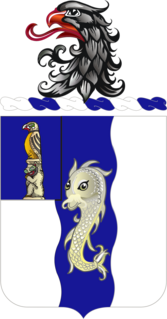
The 50th Infantry Regiment is a United States Army infantry regiment.
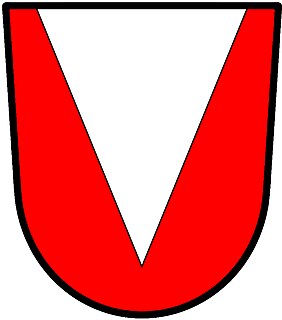
In heraldry, a pile is a charge usually counted as one of the ordinaries. It consists of a wedge emerging from the upper edge of the shield and converging to a point near the base. If it touches the base, it is blazoned throughout.

The 12th Field Artillery Regiment is a unit of the United States Army.

The 385th Infantry Regiment was part of the 76th Infantry Division of the US Army during World War II and fought in Germany, including the Siegfried Line. The 385th's 2nd Battalion crossed the Nims River at Niederweis taking the town while the 1st Battalion attacked south between Nims and the Prum toward Irrel. 3rd Battalion was the first of the regiment to span the Sauer and go into action in Germany. The first days of combat were a series of pillboxes and prepared defenses until the Line had been breached and the Regiment began moving at an ever accelerated speed.

The 48th Infantry Regiment is an infantry regiment in the United States Army first formed in 1917.

The 17th Field Artillery Regiment is a field artillery regiment of the United States Army first formed in 1916.

The 18th Field Artillery Regiment is a field artillery regiment of the United States Army first formed in 1916.

The 28th Field Artillery Regiment is a field artillery regiment of the United States Army, first constituted in 1918 in the National Army (USA).
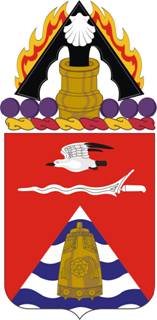
The 31st Field Artillery Regiment is a field artillery regiment of the United States Army, first Constituted in 1918 in the National Army (USA). The 1st Battalion, 31st Field Artillery, was constituted 5 July 1918 in the National Army as the 31st Field Artillery and assigned to the 11th Division. The "Proud American" Battalion was organized at Camp George G. Meade, Maryland 6 August 1918 but relieved thereafter from its assignment to the 11th Division on 30 September 1918. The unit demobilized 9 December 1918 at Camp George G. Meade, Maryland. On 22 July 1929, 31st FA was reconstituted in the Regular Army and assigned to the 2nd Division but was, once again, later relieved on 1 January 1930 from its assignment to the 2nd Division. The "Proud American" Battalion was subsequently assigned to the 7th Division on 1 July 1940 and activated at Camp Ord, California where it was reorganized and re-designated as the 31st Field Artillery Battalion on 1 October 1940. It underwent another reorganization and re-designation on 1 July 1957 as the 31st Field Artillery, "Always First," which was a parent regiment under the Combat Arms Regimental System. 31st FA was then withdrawn from the Combat Arms Regimental System 16 March 1989, reorganized under the United States Army Regimental System, and transferred to the United States Army Training and Doctrine Command (TRADOC). The unit was re-designated as the 31st Field Artillery Regiment on 1 October 2005 and began the reactivation process on 1 October 2010, attaining operational capacity under the 434th Field Artillery Brigade and activated on 11 January 2011. The "Proud American" Battalion is credited with participating in multiple campaigns in World War II and the Korean War. It has been distinguished with several decorations, to include the Philippine Presidential Unit Citation and the Republic of Korea Presidential Unit Citation that was awarded on three separate occasions.

The 300th Field Artillery Regiment is a Field Artillery regiment of the United States Army.
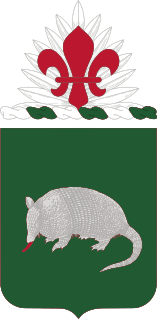
The 35th Armored Regiment is a regiment of the United States Army first established in 1941. The lineage of the regiment is carried on by the 1st Battalion 35th Armored Regiment, currently attached to the 2nd Brigade Combat Team, 1st Armored Division.
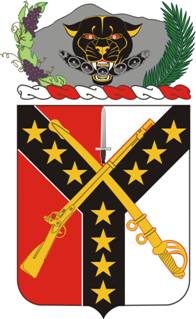
The 61st Cavalry Regiment is a regiment of the United States Army first established in 2004. The 1st, 2nd and 4th Squadrons are inactive. The 3rd Squadron is assigned to the 2nd Brigade Combat Team, 4th Infantry Division.

The 98th Cavalry Regiment is a parent regiment of the United States Army established in 2006. It is represented in the Mississippi Army National Guard by the 1st Squadron, 98th Cavalry, an element of the 155th Armored Brigade Combat Team.

The 40th Infantry Regiment is an inactive infantry regiment in the United States Army.
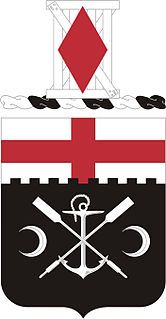
The 7th Engineer Battalion is a unit of the United States Army located at Fort Drum, New York. This battalion falls under the 10th Mountain Division's 1st Brigade Combat Team. The battalion has the Brigade Combat Team's engineer companies, military intelligence company, and signal company.


















